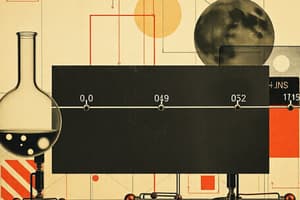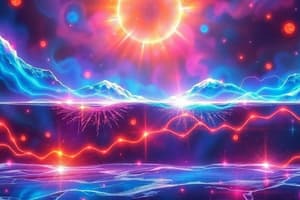Podcast
Questions and Answers
How does adding a product to a reaction at equilibrium affect the system?
How does adding a product to a reaction at equilibrium affect the system?
- The equilibrium constant increases.
- The equilibrium position remains unchanged.
- The equilibrium position shifts to the left. (correct)
- The reaction rate decreases.
What is the equilibrium constant ($K$) for the reaction where $[NO_2] = 15.5$, $[NO] = 0.0542$, and $[O_2] = 0.127$?
What is the equilibrium constant ($K$) for the reaction where $[NO_2] = 15.5$, $[NO] = 0.0542$, and $[O_2] = 0.127$?
- 6.44 imes 10^5 (correct)
- 4.00 imes 10^5
- 8.00 imes 10^5
- 7.34 imes 10^5
Which of the following changes the value of the equilibrium constant ($K$)?
Which of the following changes the value of the equilibrium constant ($K$)?
- Change in volume
- Change in pressure
- Change in temperature (correct)
- Change in concentration
In the equilibrium expression for a reaction involving solid components, what states are included?
In the equilibrium expression for a reaction involving solid components, what states are included?
What occurs when a reactant is removed from a system at equilibrium?
What occurs when a reactant is removed from a system at equilibrium?
When gaseous arsenic ($As_4$) is removed from the system $AS_4O_6(s) + 6C(s) \rightleftharpoons AS_4(g) + 6CO(g)$, what happens to the equilibrium position?
When gaseous arsenic ($As_4$) is removed from the system $AS_4O_6(s) + 6C(s) \rightleftharpoons AS_4(g) + 6CO(g)$, what happens to the equilibrium position?
Which of the following statements is true regarding the effect of concentration changes on a reaction at equilibrium?
Which of the following statements is true regarding the effect of concentration changes on a reaction at equilibrium?
According to Le Châtelier's principle, how does the equilibrium position respond to an increase in pressure in a gaseous reaction?
According to Le Châtelier's principle, how does the equilibrium position respond to an increase in pressure in a gaseous reaction?
What is the correct expression for the equilibrium constant, $K$, for the reaction $N_2 (g) + Cl_2 (g) \rightleftharpoons NCI_3(g)$?
What is the correct expression for the equilibrium constant, $K$, for the reaction $N_2 (g) + Cl_2 (g) \rightleftharpoons NCI_3(g)$?
For the dissociation of acetic acid represented by the equation $CH_3COOH \rightleftharpoons H_3O^+ + CH_3COO^-$, which constant is used to express the equilibrium?
For the dissociation of acetic acid represented by the equation $CH_3COOH \rightleftharpoons H_3O^+ + CH_3COO^-$, which constant is used to express the equilibrium?
Which of the following is a characteristic of heterogeneous equilibrium?
Which of the following is a characteristic of heterogeneous equilibrium?
According to Le Châtelier's Principle, what will occur if the concentration of $SO_2$ is decreased in the equilibrium $2SO_3 \rightleftharpoons 2SO_2 + O_2$?
According to Le Châtelier's Principle, what will occur if the concentration of $SO_2$ is decreased in the equilibrium $2SO_3 \rightleftharpoons 2SO_2 + O_2$?
What is the equilibrium-constant expression for the formation of a complex ion represented by $Ni^{2+} + 4CN^- \rightleftharpoons [Ni(CN)_4]^{2-}$?
What is the equilibrium-constant expression for the formation of a complex ion represented by $Ni^{2+} + 4CN^- \rightleftharpoons [Ni(CN)_4]^{2-}$?
Given that $K = 2.1 \times 10^3$ for the reaction $H_2 + F_2 \rightleftharpoons 2HF$, if the concentrations of $H_2$ and $F_2$ are both $0.0021 M$, what is the expected concentration of $HF$ at equilibrium?
Given that $K = 2.1 \times 10^3$ for the reaction $H_2 + F_2 \rightleftharpoons 2HF$, if the concentrations of $H_2$ and $F_2$ are both $0.0021 M$, what is the expected concentration of $HF$ at equilibrium?
In the reaction $I_2(aq) \rightleftharpoons I_2(org)$, which of the following statements accurately describes the equilibrium constant expression?
In the reaction $I_2(aq) \rightleftharpoons I_2(org)$, which of the following statements accurately describes the equilibrium constant expression?
What is the equilibrium constant expression for the reaction $4NH_3(g) + 7O_2
ightleftharpoons 4NO_2(g) + 6H_2O(g)$?
What is the equilibrium constant expression for the reaction $4NH_3(g) + 7O_2 ightleftharpoons 4NO_2(g) + 6H_2O(g)$?
For the heterogeneous equilibrium $CaCO_3(s)
ightleftharpoons CaO(s) + CO_2(g)$, which component is included in the equilibrium expression?
For the heterogeneous equilibrium $CaCO_3(s) ightleftharpoons CaO(s) + CO_2(g)$, which component is included in the equilibrium expression?
How does increasing the concentration of $NH_3$ affect the equilibrium of the reaction $4NH_3(g) + 7O_2
ightleftharpoons 4NO_2(g) + 6H_2O(g)$ according to Le Chatelier's principle?
How does increasing the concentration of $NH_3$ affect the equilibrium of the reaction $4NH_3(g) + 7O_2 ightleftharpoons 4NO_2(g) + 6H_2O(g)$ according to Le Chatelier's principle?
What is the correct equilibrium expression for the homogeneous reaction: $2H_2O(g)
ightleftharpoons 2H_2(g) + O_2(g)$?
What is the correct equilibrium expression for the homogeneous reaction: $2H_2O(g) ightleftharpoons 2H_2(g) + O_2(g)$?
Given the equilibrium concentrations [NO]= $0.0542 M$, [O2] = $0.127 M$, and [NO₂] = $15.5 M$ for the reaction $2NO(g)+O_2(g)
ightleftharpoons 2NO_2$, what is the equilibrium constant at $230^ ext{°C}$?
Given the equilibrium concentrations [NO]= $0.0542 M$, [O2] = $0.127 M$, and [NO₂] = $15.5 M$ for the reaction $2NO(g)+O_2(g)
ightleftharpoons 2NO_2$, what is the equilibrium constant at $230^ ext{°C}$?
When discussing homogeneous equilibrium, which statement is true?
When discussing homogeneous equilibrium, which statement is true?
What happens to the equilibrium when the temperature is increased for an exothermic reaction?
What happens to the equilibrium when the temperature is increased for an exothermic reaction?
In the equilibrium expression $K =
rac{[C]^c[D]^d}{[A]^a[B]^b}$, what does the symbol $K$ represent?
In the equilibrium expression $K = rac{[C]^c[D]^d}{[A]^a[B]^b}$, what does the symbol $K$ represent?
Flashcards are hidden until you start studying
Study Notes
Chemical Equilibrium
- Chemical equilibrium is reached when the rates of the forward and reverse reactions are equal, and the concentrations of the reactants and products no longer change with time.
The equilibrium constant
- The equilibrium constant (K) is a value that represents the ratio of products to reactants at equilibrium, at a constant temperature.
- The equilibrium constant expression is derived from the law of mass action.
- K is temperature dependent.
- Concentrations are expressed in molarity (M).
Types of Equilibrium
- Homogeneous Equilibrium: All reacting species are in the same phase.
- Heterogeneous Equilibrium: Reactants and products are in different phases.
Equilibrium Constant: Example
- The equilibrium constant (K) for the reaction 2NO(g) + O2(g) <-> 2NO2(g) at 230°C is 6.44 x 10^5.
Le Chatelier's Principle
- Le Chatelier's Principle states that if an external stress is applied to a system at equilibrium, the system will shift in a direction that relieves the stress.
- This shift in direction can be predicted by analyzing the change in concentration, temperature, or pressure.
Le Chatelier's Principle: Effects of Concentration
- Adding reactants or products shifts the equilibrium in the direction that lowers the concentration of the added component.
- Removing reactants or products shifts the equilibrium in the direction that increases the concentration of the removed component.
- Only the position of equilibrium is affected by changes in concentration, not the value of K.
Le Chatelier's Principle: Effect of Temperature
- Changes in temperature affect both the position of equilibrium and the value of K.
- It is important to identify whether the reaction is exothermic (heat released) or endothermic (heat absorbed) to determine the direction of shift.
Equilibria and Equilibrium Constants in Analytical Chemistry
- Ion-product constant (KwK_wKw): Describes the dissociation of water into hydronium and hydroxide ions.
- Solubility product (KspK_{sp}Ksp): Represents the equilibrium between a slightly soluble substance and its ions in a saturated solution.
- Dissociation constant (KaK_aKa or KbK_bKb): Describes the dissociation of a weak acid or base.
- Formation constant (βnβ_nβn): Represents the formation of a complex ion.
- Oxidation/reduction equilibrium constant (KredoxK_{redox}Kredox): Describes redox reactions.
- Distribution equilibrium constant (KdK_dKd): Represents the distribution of a solute between immiscible solvents.
Studying That Suits You
Use AI to generate personalized quizzes and flashcards to suit your learning preferences.




